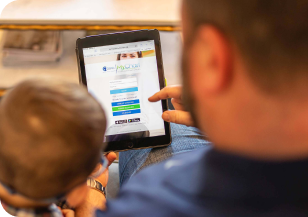GIVE NOW before 2025 ends—your gift will be doubled to help children in need. Click here to 2x your impact!

Ranked nationally in pediatric care.
Arkansas Children's provides right-sized care for your child. U.S. News & World Report has ranked Arkansas Children's in seven specialties for 2025-2026.

It's easier than ever to sign up for MyChart.
Sign up online to quickly and easily manage your child's medical information and connect with us whenever you need.

We're focused on improving child health through exceptional patient care, groundbreaking research, continuing education, and outreach and prevention.

When it comes to your child, every emergency is a big deal.
Our ERs are staffed 24/7 with doctors, nurses and staff who know kids best – all trained to deliver right-sized care for your child in a safe environment.

Arkansas Children's provides right-sized care for your child. U.S. News & World Report has ranked Arkansas Children's in seven specialties for 2025-2026.

Looking for resources for your family?
Find health tips, patient stories, and news you can use to champion children.

Support from the comfort of your home.
Our flu resources and education information help parents and families provide effective care at home.

Children are at the center of everything we do.
We are dedicated to caring for children, allowing us to uniquely shape the landscape of pediatric care in Arkansas.

Transforming discovery to care.
Our researchers are driven by their limitless curiosity to discover new and better ways to make these children better today and healthier tomorrow.

We're focused on improving child health through exceptional patient care, groundbreaking research, continuing education, and outreach and prevention.

Then we're looking for you! Work at a place where you can change lives...including your own.

When you give to Arkansas Children's, you help deliver on our promise of a better today and a healthier tomorrow for the children of Arkansas and beyond

Become a volunteer at Arkansas Children's.
The gift of time is one of the most precious gifts you can give. You can make a difference in the life of a sick child.

Join our Grassroots Organization
Support and participate in this advocacy effort on behalf of Arkansas’ youth and our organization.

Learn How We Transform Discovery to Care
Scientific discoveries lead us to new and better ways to care for children.

Learn How We Transform Discovery to Care
Scientific discoveries lead us to new and better ways to care for children.

Learn How We Transform Discovery to Care
Scientific discoveries lead us to new and better ways to care for children.

Learn How We Transform Discovery to Care
Scientific discoveries lead us to new and better ways to care for children.

Learn How We Transform Discovery to Care
Scientific discoveries lead us to new and better ways to care for children.

Learn How We Transform Discovery to Care
Scientific discoveries lead us to new and better ways to care for children.

When you give to Arkansas Children’s, you help deliver on our promise of a better today and a healthier tomorrow for the children of Arkansas and beyond.

Your volunteer efforts are very important to Arkansas Children's. Consider additional ways to help our patients and families.

Join one of our volunteer groups.
There are many ways to get involved to champion children statewide.

Make a positive impact on children through philanthropy.
The generosity of our supporters allows Arkansas Children's to deliver on our promise of making children better today and a healthier tomorrow.

Read and watch heart-warming, inspirational stories from the patients of Arkansas Children’s.

Hello.

Arkansas Children's Hospital
General Information 501-364-1100
Arkansas Children's Northwest
General Information 479-725-6800


Diabetes and Safe Driving: How Teens Can Monitor Their Blood Sugar on the Road
Published date: October 31, 2019
Updated date: May 23, 2024
Since a hypoglycemic attack often occurs without warning, planning and preparation are essential for all children with diabetes. That’s especially true for teens behind the wheel of a car. Driving with low blood sugar can be dangerous and even life-threatening, but there are steps a family can take to prepare in case the situation presents itself.
Check Your Blood Sugar Level Before You Drive
Teens with diabetes need to know the status of their blood glucose level at all times but especially before they get behind the wheel. If their blood sugar level is above 70 mg/dL, they should be safe to get behind the wheel. If that level is at or below 70 mg/dL, however, they need to take action to raise that number before they start driving. To get their blood glucose back to an appropriate level, teens should immediately act by consuming 15 grams of a fast-acting carbohydrate in the form of juice, soda glucose tablets or any sugar based item that does not contain protein.
After 15 minutes, teens should recheck their blood glucose level to make sure the food or drink is doing its job to bring the blood sugar up. Once the blood sugar level rises above the healthy level of 70 mg/dL, another snack with complex carbs and proteins will ensure that the blood glucose stays at an appropriate level. Yogurt with fruit, apples with peanut butter, or almonds are good choices.
If your teen uses a Continuous Glucose Monitor (CGM), always do a manual finger stick if the blood sugar is below 70 mg/dL. If the blood sugar is above 70 mg/dL but arrows indicate that blood sugar will trend below 70 during drive time, a small snack of 10 – 15 grams of carbs and protein can help maintain blood sugar and prevent hypoglycemia.
Watch for Signs of Hypoglycemia
A teen with diabetes knows their body better than anyone else. Chances are, they have already experienced a hypoglycemic episode at some point in their life. Therefore, they recognize the warning signs. Still, with countless distractions like smartphones, the radio and other people in the car, teens must remain mindful of their own body and be aware of any signs that they may be at risk for low blood sugar.
Headaches, sweating, weakness, confusion and shakiness or tremors can all be symptoms of low blood sugar. If a teen experiences any of these while driving, they should pull over immediately and check their blood glucose level. If it is at or below 70 mg/dL , the "rule of 15" with 15 grams of a fast-acting carbohydrate and testing again 15 minutes later should be implemented. Teens should not resume driving until the symptoms have subsided and their blood glucose level rises above 70 mg/dL once again.
Prepare a Diabetic "Go Bag" for the Car
Much like children who carry a "go-bag" with diabetes equipment with them to school, teens should have everything they need to manage low blood sugar on-the-go available in their car. Glucose meters, snacks and a glucagon kit are essential items for teens with diabetes. While glucose meters should need to be readily available, they should not be kept in the car at all times. Extreme hot or cold temperatures can cause damage to the meter and limit its ability to provide accurate glucose readings.
As severe low blood sugar can lead to a seizure or unconsciousness, teens with diabetes should also have medical identification in the event of an accident. A bracelet, necklace or anything else on the body that identifies them as someone with diabetes is essential for first responders so they can immediately check glucose levels and administer the necessary treatment. It could mean the difference between life and death after an accident.

Appointments
New and existing patients can visit our appointment hub for several ways to request an appointment, including online scheduling for many services.
Request an appointment

